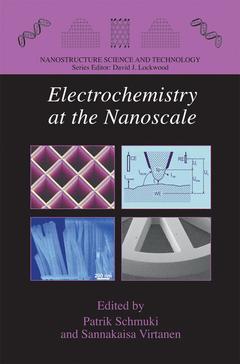Description
Electrochemistry at the Nanoscale, 2009
Nanostructure Science and Technology Series
Coordinators: Schmuki Patrik, Virtanen Sannakaisa
Language: English
Subject for Electrochemistry at the Nanoscale:
Publication date: 11-2014
471 p. · 15.5x23.5 cm · Paperback
Publication date: 01-2009
471 p. · 15.6x23.4 cm · Hardback
Description
/li>Contents
/li>Comment
/li>
For centuries, electrochemistry has played a key role in technologically important areas such as electroplating or corrosion. In recent decades, electrochemical methods are receiving increasing attention in important strongly growing fields of science and technology such as nanosciences (nanoelectrochemistry) and life-sciences (organic and biological electrochemistry).
Characterization, modification and understanding of various electrochemical interfaces or electrochemical processes at the nanoscale, has led to a huge increase of the scientific interest in electrochemical mechanisms as well as of application of electrochemical methods in novel technologies. This book presents exciting emerging scientific and technological aspects of the introduction of the nanodimension in electrochemical approaches are presented in 12 chapters/subchapters.
As nanosciences and nanoengineering are considered core technologies for the 21st century and strongly growing fields, the impact of the book can be expected to be very significant.
The book contains theoretical and applied contributions in the different fields of nanoelectrochemistry, and hence will be of interest in a large scientific area.
The concept of the book should allow using it additionally as an accompanying text book for advanced level undergraduate students in natural sciences of engineering.
For industries in the fields of microtechnology or emerging novel technologies, the book represents a compendium of recent developments and contains a toolbox of nanoelectrochemical principles and approaches.

